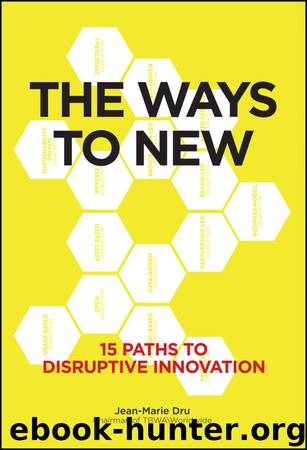The Ways to New by Jean-Marie Dru

Author:Jean-Marie Dru
Language: eng
Format: epub
ISBN: 9781119167976
Publisher: Wiley
Published: 2015-12-07T00:00:00+00:00
Notes
1. Radjou, Navi, Prabhu, Jaideep, and Ahuja, Simone (2013). L'Innovation Jugaad. Redevenons Ingénieux! France, Les Éditions Diateino.
2. Richaud, Nicolas (www.lesechos.fr, June 10, 2015). “Spotify atteint les 20 millions d'abonnés payants et se prépare à faire face à Apple.”
3. Olanoff, Drew (www.techcrunch.com, March 6, 2013). “ZipDial has turned 400M missed calls into moneymaking connections.”
Chapter 13
Added-Service Disruption
In this Internet age, products are becoming services and services are becoming products. More exactly: material goods are increasingly augmented with related services. And services are often embodied within a physical object.
Some six or seven years ago, an app called Hello Baby1 attracted my notice. It offered a two-minute video showing how the fetus grows every week. The images were riveting. In week eighteen, a tiny human being acquires fingers. Ten weeks later, he can be seen reacting to exterior sounds. This video was produced by Pampers just a few months after the first smartphone apps emerged. Mothers could download the app and add personal details, including baby due date, gender, size, and weight and so chart week-by-week development. And share their baby's progress with their friends on Facebook.
An African proverb states, “It takes a village to raise a child.”2 So Pampers has built a “Pampers Village” for the digital era on its website. Mothers sign up to find all kinds of useful advice about pregnancy and the first months of a newborn's life, including nutrition, safety, sleep, and skincare…
Basically, Procter & Gamble has chosen to add services to its products in order to make them more useful. The company expects every one of its brands to offer not just a functional benefit—in the case of Pampers, drier bottoms—but also to acquire a purpose. In other words, the Pampers brand, beyond product benefits, does what it can to help smooth babies' growth and improve mothers' welfare.
Programs and apps like Hello Baby are rooted in the “brand-utility” concept. Nike has brilliantly illustrated this trend over nearly ten years with its “Nike+ Fuelband,” a service so appreciated by its thirty million users that CEO Mark Parker now describes his brand's universe as “digital sport.”3 The way it works forms a circle, from sneakers to associated service, itself embodied in a physical bracelet.
“Fast followers”—companies that are the first to imitate innovative enterprises—are so quick off the mark that it is hard for the trailblazers to keep ahead of the game. Commoditization is the underlying danger. One way of avoiding or at least delaying this threat, inherent in technological proliferation, is by coming up with a service. Added services initiate conversations between brand and customer. They build customer loyalty.
Jean-Paul Agon, the Chairman and CEO of L'Oréal, thinks that usefulness is part of beauty. “The digital revolution is changing the nature of what we offer,” he once declared in a press interview. “Until now, we sold only products. From now on, we will be selling a combination of product together with a related service.”4 Tutorials help customers improve their mascara- and foundation-application skills. They teach women how wrinkles come about and strengthen their ability to fight the effects of stress, pollution or menopause on skin.
Download
This site does not store any files on its server. We only index and link to content provided by other sites. Please contact the content providers to delete copyright contents if any and email us, we'll remove relevant links or contents immediately.
| Direct | Global |
| Industrial | Multilevel |
| Product Management | Research |
| Telemarketing | Web Marketing |
Influence: The Psychology of Persuasion by Robert B. Cialdini(4173)
The Miracle Morning by Hal Elrod(3903)
The Hacking of the American Mind by Robert H. Lustig(3575)
Pre-Suasion: A Revolutionary Way to Influence and Persuade by Robert Cialdini(3404)
Unlabel: Selling You Without Selling Out by Marc Ecko(2974)
Hidden Persuasion: 33 psychological influence techniques in advertising by Marc Andrews & Matthijs van Leeuwen & Rick van Baaren(2771)
Who Can You Trust? by Rachel Botsman(2728)
Kick Ass in College: Highest Rated "How to Study in College" Book | 77 Ninja Study Skills Tips and Career Strategies | Motivational for College Students: A Guerrilla Guide to College Success by Fox Gunnar(2716)
Purple Cow by Seth Godin(2693)
Ogilvy on Advertising by David Ogilvy(2677)
I Live in the Future & Here's How It Works by Nick Bilton(2520)
This Is Marketing by Seth Godin(2476)
The Marketing Plan Handbook: Develop Big-Picture Marketing Plans for Pennies on the Dollar by Robert W. Bly(2408)
The Power of Broke by Daymond John(2373)
Building a StoryBrand by Donald Miller(2356)
The 46 Rules of Genius: An Innovator's Guide to Creativity (Voices That Matter) by Marty Neumeier(2305)
Draw to Win: A Crash Course on How to Lead, Sell, and Innovate With Your Visual Mind by Dan Roam(2275)
The Tipping Point by Malcolm Gladwell(2198)
Market Wizards by Jack D. Schwager(2154)
